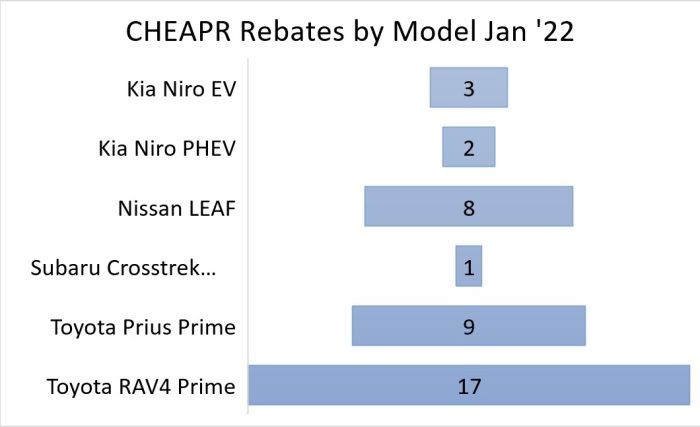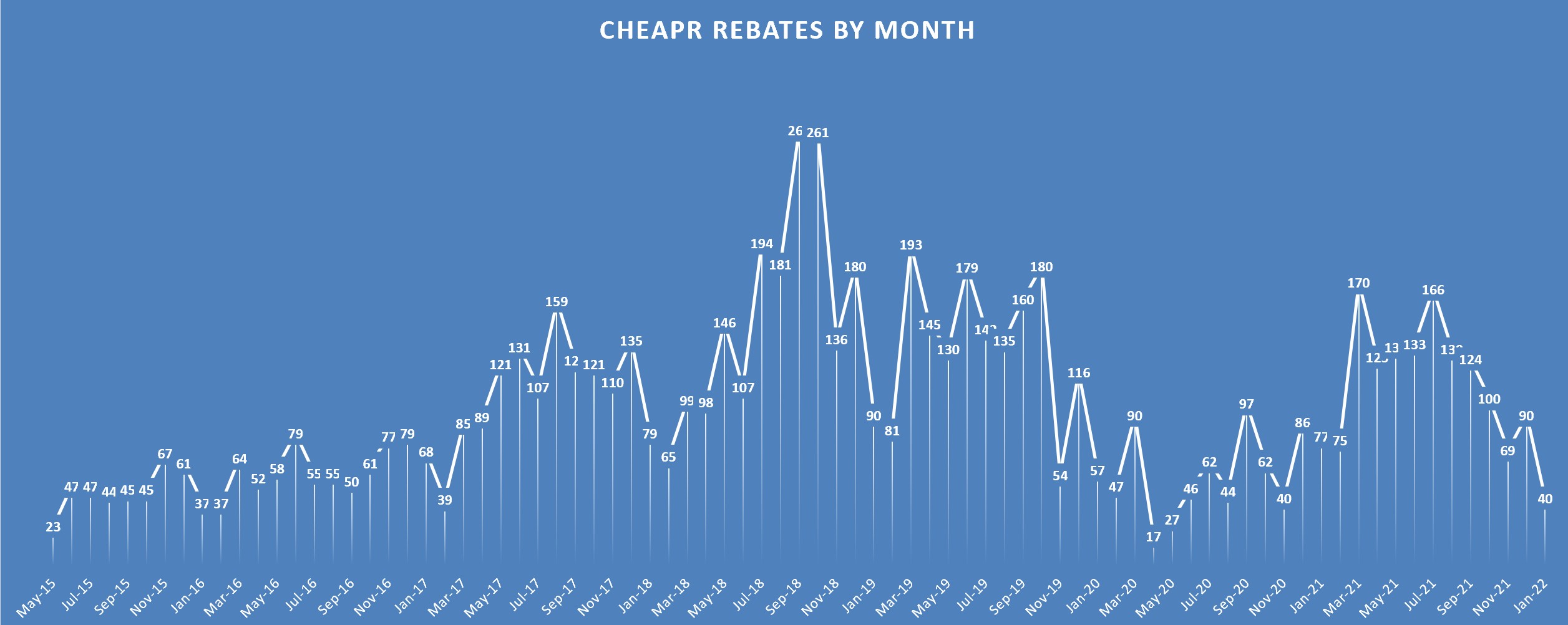Help Needed to Remedy Persistently Low Rebate Levels
As can be seen in the chart at the top, the rebate count for January was exceedingly low with only 40 rebates, just over half of the low number of 78 from January 2021.
Continuing recent trends, the Toyota RAV4 Prime plug-in hybrid dominated with 17 rebates, with PHEVs overall accounting for 28 of the 40 rebates.

Some changes could be afoot if SB-4, raised jointly by the Transportation and Environment Committees of the legislature, become law. There are several CHEAPR-related provisions included in the draft text. This is the description to the best of our knowledge.
Environmental Justice Focus
There is a statement of purpose now that focuses on environmental justice communities and lower income individuals. It is phrased as, “The commissioner shall prioritize the granting of rebates to residents of environmental justice communities, residents having household incomes at or below three hundred per cent of the federal poverty level, and residents who participate in state and federal assistance programs, including, but not limited to, the state-administered federal Supplemental Nutrition Assistance Program, state-administered federal Low Income Home Energy Assistance Program, or a Head Start program established pursuant to section 10-16n. The program shall provide rebates of five thousand dollars to residents of environmental justice communities.”
This represents a loosening of rules for income limited individuals, often referred to by the shorthand LMI. Currently, only participants in state and federal assistance plans are eligible for the Rebate+ incentives and very few have been used. There were zero in January. This expansion to 300% of the federal poverty level should expand the pool. The poverty level for a family of 4 is $27,750. Aside from an overly limited applicant pool, the rebate+ incentives arguably suffer from being awarded after the fact. If that can be addressed, it would be up to DEEP and the board to determine the process.
The LMI incentive is increased to $5000. Currently, a BEV carries a total incentive of $4250. It is not clear if $5,000 applies to everything.
Standard Rebate and Higher MSRP Cap
The standard rebate still exists and the rules are below.
MSRP cap increase to $50,000. This is the level where it was before being lowered in 2019 to $42,000, which began the chronic underspending and has more recently resulted in a program tilted heavily toward PHEVs. For example, over the past 4 months, BEVs accounted for 30% of CHEAPR rebates, but represent 59% of all registered EVs.
While the EV Club has pushed for a restoration of the $50,000 level for the past couple of years, in the current inflationary environment, it arguably could be higher. The average transaction price of an EV, according to Kelly Blue Book, is $56,437 (excluding Tesla). The marketplace has blown through the cap level.
Inclusion of Fleets
Expansion of program to include municipalities, businesses, organizations, and tribal entities. These organizations are entitled to up to 10 rebates per year up to a max total of 20. Organizations located in an environmental justice community can receive more at the discretion of the DEEP Commissioner. This could be a big help.
eBikes
eBikes are now included with a rebate of $500 for a bike costing no more than $2,000. In the Transport Hartford/Center for Latino Progress meetings, they have said that $2,000 isn’t enough for a quality bike. We support eBike rebates, along with their efforts to advocate for a higher price cap.
Higher Budget
The CHEAPR budget established in the 2019 legislation is $3MM per year, which has been underspent since the day it started. With the expansion of incentives described in this post, the spend level looks to be considerably higher. The proposed legislation authorizes the program to spend “a minimum of $3MM per year.” This indicates that more funds are forthcoming, but it doesn’t specify a cap. CHEAPR funding comes from the clean air fees collected as part of auto registration. These fees bring in about $8MM per year. $3MM have been going to CHEAPR with the rest having gone to the general fund. The new legislation designates that 57.5% go to transportation funding, though it is possible that other programs could be included.
Board
There are proposed changes to the board, specifically the inclusion of a “representative of an association representing electric vehicle manufacturers,” and a “representative of an association representing electric vehicle consumers.” For the former, we don’t know if this is a way to draw in the new EV-exclusive manufacturers or if it can be filled by an organization such as the Automotive Alliance which represents legacy OEMs. The manufacturer representative is appointed by the Senate President Pro Tempore. The consumer organization representative is appointed by the House minority leader. These replace 2 current positions appointed by the same individuals. Those positions are currently filled and it is not known if those people will depart.
There are also a couple of unfilled board positions, appointed at large by DEEP, and designated for representatives of an industrial fleet or transportation company.
The board is characterized as operating in an advisory capacity so it is not completely clear how much power they have when it comes to setting policy.
Other Legislative Items
In this and other bills, there are other items of note.
- Right to charge legislation to make it easier for residents (owners and renters) to be able to install a charging station.
- Adoption of California medium and heavy duty vehicle emission standards, pending results of DEEP analysis. (Does anyone seriously doubt we desperately need this??) Update: DEEP released their expected endorsement of this measure on March 9th. (This is bill HB-5039.)
- Allowance for school to enter into 10-year contracts for EV school buses. Currently, only 5-year contracts are allowed. For EV buses, 10 years are needed to make the numbers work.
- Accelerated purchases of smart traffic signals (yes, this really does reduce emissions).
- EV charging stations that go beyond the federal Infrastructure bill and highway corridors to cover communities with lack of charging access.
- Active transportation – pedestrian and bike paths.
- Any project involving state funds must not add to carbon emissions. If it does, there needs to be offsets.
Advocacy:
We are supportive this bill. There are many good things in it. We would prefer an MSRP cap of $55,000 for CHEAPR to reflect the realities of the electric car marketplace, as well as a higher cap on the cost of eBikes.
Go here to find your legislators and contact information.
The Transportation Committee and the Environment Committee will hold a joint public hearing on Friday, March 11, 2022 at 11:00 A.M. via Zoom. The public hearing can be viewed via YouTube Live. In addition, the public hearing may be recorded and broadcast live on CT-N.com. Individuals who wish to testify via Zoom must register using the On-line Testimony Registration Form. Registration will close on Thursday, March 10, 2022 at 3:00 P.M. Speaker order of approved registrants will be posted on the Transportation Committee website on Thursday, March 10, 2022 at 6:00 P.M. under Public Hearing Testimony. If you do not have internet access, you may provide testimony via telephone. To register to testify by phone, call the Phone Registrant Line at (860) 240-0590 to leave your contact information. Please email written testimony in PDF format to TRAtestimony@cga.ct.gov. Testimony should clearly state testifier name and related Bills. The Committee requests that testimony be limited to matters related to the items on the Agenda. The first hour of the hearing is reserved for Legislators, Constitutional Officers, State Agency Heads and Chief Elected Municipal Officials. Speakers will be limited to three minutes of testimony. The Committee encourages witnesses to submit a written statement and to condense oral testimony to a summary of that statement. All public hearing testimony, written and spoken, is public information. As such, it will be made available on the CGA website and indexed by internet search engines.


There should also be a provision to allow people who already purchased this year to receive the rebate after the fact if they raise the MSRP cap to include the vehicle they purchased. This will help with utilizing all that cash they haven’t spent. The window to apply should apply to the whole year, not weeks like it currently is.